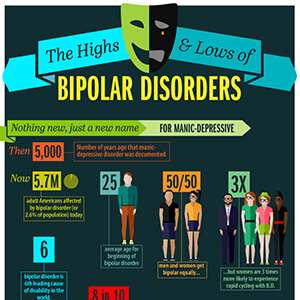The Highs and Lows of Bipolar Disorders
Nothing new, just a new name
for Manic-Depressive
Then:
5,000: Number of years ago that manic-depressive disorder was documented
Now:
5.7 million: number of adult Americans affected by bipolar disorder (or 2.6% of population) today
25: average age for beginning of bipolar disorder
50/50: men and women get bipolar equally
3X: But women are 3 times more likely to experience rapid cycling with B.D.
6: Bipolar disorder is 6th leading cause of disability in the world.
9.2: Number of years subtracted from your lifespan if you have B.D.
8 of 10: Number of those with B.D. who think about suicide at least once in their life.
1 in 12: Number of those in general population who will think about suicide in their life
A worldwide condition
– In Australia there are around 238,957 people with bipolar disorder.
– In the UK: 723,248 people.
– Germany: 989,095
– Canada: 390,094
– Iran: 810,038
– India and China, each have 12 – 15 million people who are bipolar
Cause: Unknown (Mayo Clinic)
Theories:
Biological differences in their brains
Neurotransmitter imbalance
An inherited trait
Diagnosis facts
70: Percent of people with Bi-Polar who receive at least 1 misdiagnosis
25: Percent of people who receive correct diagnosis within 3 years
23: Percent chance that a child will be bipolar if 1 parent is
66: Percent when both parents are bipolar
Signs and symptoms
Mania:
• Inflated self-esteem or grandiosity
• Decreased need for
• Unusual talkativeness
• Racing thoughts
• Distractibility
• Agitation
• Unusual behavior with high potential for painful consequences —unrestrained buying sprees, sexual indiscretions or foolish business investments
Depression:
• Depressed mood most of the day, nearly every day, such as feeling sad, empty, hopeless or tearful
• Can appear as irritability
• Markedly reduced interest or feeling no pleasure
• Significant weight loss when not dieting, weight gain, or decrease or increase in appetite
• Either insomnia or sleeping excessively
• Fatigue
• Feeling worthless
• Decreased ability to concentrate, or indecisiveness
• Recurrent thoughts of death or suicide, or suicide planning or attempt
Featured Programs
Factoid
25: Percentage of those diagnosed with bipolar disorder who commit suicide
Getting Help
If you think you may hurt yourself call 911
Other options:
Reach out to a close friend or loved one.
Contact a minister or spiritual leader
Call a suicide hotline number — in U.S., call the National Suicide Prevention Lifeline at 800-273-TALK (800-273-8255). Use same number, press 1 to reach the Veterans Crisis Line.
Make an appointment with your doctor, mental health provider or other health care provider.
Treatment options
Medication (mood stabilizers, anti-depressants, anti-anxiety meds)
Psychological counseling (psychotherapy)
Light and Dark therapy (focus on sleep-wake cycle)
Education (managing symptoms)
Lifestyle management (i.e. avoid alcohol and drugs, minimize stress, keep to regular sleep)
Mindfulness meditation
Acupuncture (works, in some cases)
Electroconvulsive therapy (in the most severe cases)
Support (from trained groups, plus family and friends)
Famous Celebs with Bipolar Disorder
Demi Lovato, actress, pop singer
Carrie Fisher, Princess Leia
Jean-Claude Van Damme, rugged action star
Linda Hamilton, actress (Terminator 2)
Sinead O’Connor, Irish rock star
Vincent Van Gough, according to Doctor Who, the best artist in the history of the Universe
Sources:
http://healthresearchfunding.org/40-profound-bipolar-disorder-suicide-statistics/
http://www.nimh.nih.gov/health/publications/bipolar-disorder-in-adults/index.shtml
http://www.mayoclinic.org/diseases-conditions/bipolar-disorder/basics/causes/con-20027544

